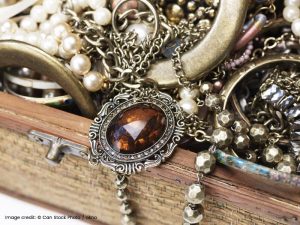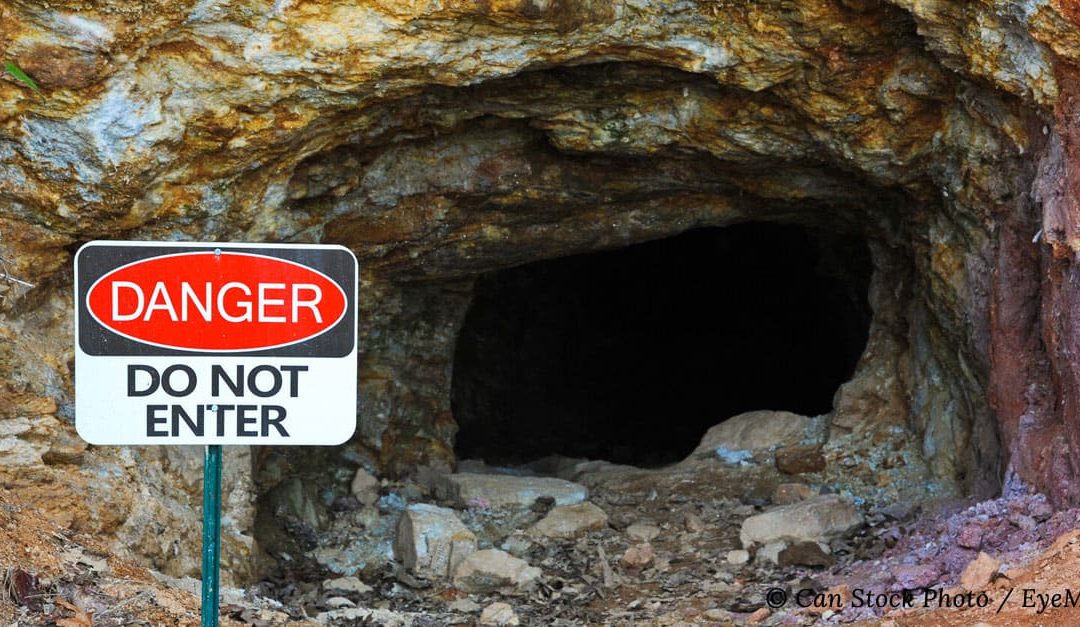Underground gold reserves are rapidly being depleted. It’s time to start thinking about making the most of the opportunities afforded by what we do have – and for the jewellery industry to think about securing future supply.
Lately I’ve been having a lot of discussions with various industry people about Artisanal Small-scale Mining (ASM). Particularly in relation to gold mining.
And always in the back of my mind is the nagging thought that the existing below ground gold reserves can’t last forever.
That means that any discussion we have now about artisanal gold mining has to be in the context of some kind of time frame. We can’t ignore what happens when the gold runs out.
Precious metals are a finite resource
Unlike diamonds and many precious gemstones, metals like silver, gold and the platinum group metals cannot be manufactured from other raw materials in a factory.
What exists on the planet Earth is all we have available. And until inter-planetary mining kicks off, sooner or later underground reserves are going to run out. (Or, what’s more likely is they will become uneconomic to recover.)
From some previous reading I had in my mind that there might be about 30 years of gold reserves still untapped, but these recent discussions have prompted me to look a little harder.
What I’ve learned is, well, sobering.
(In theory) gold reserves could run out in less than 20 years
20 years might sound like a long time, but I bet many of you can remember exactly what you were doing on New Year’s Eve 1999 …
We’re here folks. Almost 20 years down the track. Time flies doesn’t it!
In real terms, it’ll probably take more than 20 years to deplete known reserves. As gold prices go up (which they inevitably will), recycling rates are likely to increase.
On the other hand, as gold prices go up, rates of mine development and expansion will likely go up too. So they may well cancel each other out.
Only time will tell.
It’s called “burn-out”
From my reading, it seems that the science-y type people who do the hard research and build the mathematical models refer to the rate at which precious metals (and other things) will be depleted as the ‘burn-out rate’.
Very briefly, it’s an estimate of when reserves of commodities like gold will be exhausted based on a bunch of assumptions around production rates, prices, recycling, new discoveries etc.
Let’s look at some basic numbers:
- Estimated underground gold reserves at 2018: 54,000 tonnes (US Geological Survey, 2018)
- Current mine production rate (approx.): 3,300 tonnes per annum (World Gold Council, 2018)
Divide 54,000 by 3,300 and you get 16.4.
That’s 16.4 years for all known gold reserves to be exploited, assuming nothing else changes.
Of course, other things will change. Perhaps that time line will extend to 20 years? Or 25 years? Or maybe even 30?
One thing is certain though, underground gold reserves are going to ‘run out’ within most of our lifetimes.
What does this mean for the jewellery industry?
Given that jewellery manufacturing consumes about 50% of all supply (World Gold Council, 2018), as underground reserves are depleted, I’d say competition for gold is going to heat up.
Some are predicting that as we approach depletion (or burn-out) gold prices could be as high as USD $10,000-$13,000 per ounce in today’s dollars.
That’s 10 times current pricing and you’d have to think that’s going to depress demand. It might also see consumers switching to lower caratage gold jewellery? 14- and 18-carat products might well be out of most people’s reach.
I’m entirely speculating, but it’s an interesting thought.
What might happen to the recycling industry?

As gold prices go up, it’s likely more people will be inclined to recycle old jewellery. Either to remodel into new pieces, or simply to cash-out.
As gold prices go up, it’d be reasonable to expect that more gold is going to be recycled than at current rates (presently about 30% of supply).
Grandma’s unfashionable old jewellery, even the 9-carat stuff, is going to be well and truly worth selling. And e- and industrial waste will become even more valuable.
And what’s interesting to me is, while mine production costs are likely to dramatically increase as ore concentrations drop, production costs for recyclers are likely to remain stable – provided they can keep their energy costs down.
Yes, recycler’s raw materials (currently 70% old jewellery) will increase in cost too, but the yields are so much higher in the refining process that recyclers will have a huge cost advantage over their mine-based competitors.
Imagine if recyclers de-coupled their pricing from that of mined product and started undercutting the market? They could shut down mining overnight if they wanted!
Again, wild speculation. But it does beg the question about how jewellery manufacturers might secure their gold supply chains in the future.
Perhaps they’ll start vertically integrating into recycling?
We hear a lot of talk about global food and water security. Maybe it’s time the jewellery industry started talking about gold security?
What about Silver and the Platinum Group Metals?
The story around silver is like that of gold, though underground reserves are expected to last longer.
Again, according to the US Geological Survey, 2018, there is around 530,000 tonnes of silver reserves remaining underground.
Annual mine production rates are presently running at about 25,000 tonnes. Simple maths says that equates to just over 20 years of supply, but the market dynamics of recycling, pricing and demand makes that an unreliable figure.
In an article published by Ruberti & Massari in ResearchGate last year (www.researchgate.net/publication/326646043_Are_the_World-Leading_Primary_Silver_Mines_Exhausting), their extensive research and modelling suggests burn-out for silver will be around 2055. In other words, in 35 or so years’ time.
As for the platinum group metals (PGMs), the immediate future looks a bit less uncertain.
Current underground reserves are about 69,000 tonnes (US Geological Survey, 2018) with annual mine production sitting at about 530 tonnes.
Again, simple maths … that’s 130 years’ worth.
However, once again we might expect the dynamics of price, demand and the difficulties and costs of extraction and refining to stretch out that time frame.
When you consider that 66% of demand for PGMs come from the auto catalyst industry (Johnson Matthey PGM Market Report, 2018). And that globally there is a strong push to (within the next 20-30 years) replace petrol- and diesel-powered vehicles with electric- and hydrogen-powered ones, perhaps reserves of PGMs will last much, much longer than those of gold and silver?
It might also mean we see more jewellery being made with platinum and palladium in lieu of gold?
What does the medium-term future hold for ASMs?
I’m not a futurist, but I do enjoy a bit of informed speculation (as I’m sure you can tell).
And really I should get back on point, because I started out by talking about ASM.
Given the technological and capital investment challenges associated with PGM extraction and refining, I doubt we’ll see ASMs making much of a move into that group of metals.
But as prices for gold and silver go up – which they will – extracting these precious metals is going to become an even more attractive proposition for miners and governments alike.
So, what are some of the possible outcomes?:
- In countries that are politically unstable and where land rights are questionable or non-existent, I’d expect to see increasing informal and illegal mining and with that, increases in all the negatives associated with it;
- In more stable developing nations, we might see more government-sponsored support for ASM. Similarly, NGOs are freer to operate and support ASM economic development. If local costs of living do not increase in line with gold prices, then ASM will be able to compete more effectively with large scale mining operations as margins on the commodity trading price improve; or
- Alternatively, we might see some governments selling off mineral rights to large mining corporations in exchange for royalties – as we’ve seen with rubies in Mozambique. This could cause considerable local conflict but might also stimulate longer term local economic and infrastructure development.
What happens when the gold runs out?
I still haven’t answered that question with respect to ASM communities. And the short answer is, I don’t know.
It will depend entirely on what happens in the meantime.
Artisanal Small Mining, properly developed and supported, has the potential to fund a whole lot of local economic development … roads, energy production, health services, education, agriculture, small business, banking & finance, manufacturing … the list goes on.
But it is, in the grand scheme of things, a short-term opportunity.
It’s important to recognise that self-interested outsiders will want to exploit the opportunity, bleed it for whatever they can, and retain the freedom to walk away and continue elsewhere.
Local people don’t have that luxury.
As a jewellery consumer, what role do you have to play?
As a jewellery consumer, the machinations at the global raw material production level aren’t something you can have a whole lot of impact on. Really all you can do is sit back and watch it happen.
That said, you can make choices about where the money you spend goes and who and what communities it supports.
At EJA we started out, nearly 12 years ago, rejecting the negative impacts of mining (large- and small-scale), instead championing recycling and supporting fair work practices in the cutting and polishing industry.
These days, given the increasing push by several worthy organisations to improve the lives and environmental performance of ASM communities, we’re a bit more open-minded when it comes to ASM-origin gold.
We are still very concerned about the negative aspects of mining, particularly in relation to pollution, habitat destruction and climate change. But we also recognise that mining resources like gold is inevitable and supporting ASM communities can help reduce the negative impacts of mining.
As miners become more efficient, gain access to renewable energy and find alternatives to mercury-based aggregation, the rate of damage reduces.
Even so, we’re certainly not going to abandon recycling.
Because of its vastly smaller carbon footprint and local availability, recycled precious metals are still our go-to option. (Eventually it will be the only option.)
But ethically sourced ASM-gold is an alternative we’re happy to offer if that’s your preference.
*Being a bespoke, fine jewellery company that only does handmakes, we don’t work with silver because the relatively high labour cost is out of kilter with the finished value of a piece of jewellery made with it.
About EJA
Ethical Jewellery Australia is an online engagement, wedding ring specialist and bespoke jewellery specialist. Every piece we do is custom designed and made to order (with the exception of simple wedding and commitment rings that are offered in a range of simple, popular designs).
We take our customers through the whole process from design to sourcing and finally to manufacturing.
All rings are handmade in Australia with recycled metals. (We can also supply Fair Trade gold if requested.)
Likewise, we only every use ethically sourced diamonds and gemstones. You can choose from Argyle, recycled, vintage and lab-grown diamonds, Australian, US, Fair Trade, recycled and lab-grown coloured gemstones.
By the way, we offer an Australia-wide service.
About the Author: Benn Harvey-Walker
Benn is a Co-founder of Ethical Jewellery Australia and a keen student of ethical and sustainability issues in the jewellery world. He has a long history in sales and marketing and began working with EJA full time in early 2018.
Benn co-authored the original Engagement Ring Design Guide in 2014 and edited the 2nd Edition in 2018. He is also the principal author of our Wedding and Commitment Ring Design Guide.
His main responsibilities at EJA are business development and sales process management. Benn also creates technical drawings for our ring designs.


Recent Comments